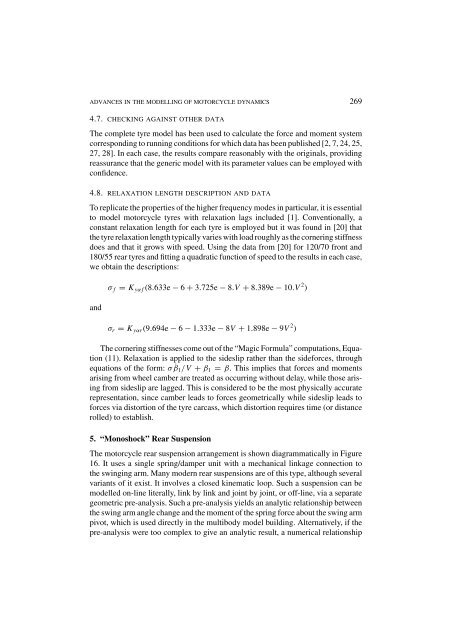Advances in the Modelling of Motorcycle Dynamics - ResearchGate
Advances in the Modelling of Motorcycle Dynamics - ResearchGate
Advances in the Modelling of Motorcycle Dynamics - ResearchGate
You also want an ePaper? Increase the reach of your titles
YUMPU automatically turns print PDFs into web optimized ePapers that Google loves.
ADVANCES IN THE MODELLING OF MOTORCYCLE DYNAMICS 2694.7. CHECKING AGAINST OTHER DATAThe complete tyre model has been used to calculate <strong>the</strong> force and moment systemcorrespond<strong>in</strong>g to runn<strong>in</strong>g conditions for which data has been published [2, 7, 24, 25,27, 28]. In each case, <strong>the</strong> results compare reasonably with <strong>the</strong> orig<strong>in</strong>als, provid<strong>in</strong>greassurance that <strong>the</strong> generic model with its parameter values can be employed withconfidence.4.8. RELAXATION LENGTH DESCRIPTION AND DATATo replicate <strong>the</strong> properties <strong>of</strong> <strong>the</strong> higher frequency modes <strong>in</strong> particular, it is essentialto model motorcycle tyres with relaxation lags <strong>in</strong>cluded [1]. Conventionally, aconstant relaxation length for each tyre is employed but it was found <strong>in</strong> [20] that<strong>the</strong> tyre relaxation length typically varies with load roughly as <strong>the</strong> corner<strong>in</strong>g stiffnessdoes and that it grows with speed. Us<strong>in</strong>g <strong>the</strong> data from [20] for 120/70 front and180/55 rear tyres and fitt<strong>in</strong>g a quadratic function <strong>of</strong> speed to <strong>the</strong> results <strong>in</strong> each case,we obta<strong>in</strong> <strong>the</strong> descriptions:andσ f = K yα f (8.633e − 6 + 3.725e − 8.V + 8.389e − 10.V 2 )σ r = K yαr (9.694e − 6 − 1.333e − 8V + 1.898e − 9V 2 )The corner<strong>in</strong>g stiffnesses come out <strong>of</strong> <strong>the</strong> “Magic Formula” computations, Equation(11). Relaxation is applied to <strong>the</strong> sideslip ra<strong>the</strong>r than <strong>the</strong> sideforces, throughequations <strong>of</strong> <strong>the</strong> form: σ ˙β 1 /V + β 1 = β. This implies that forces and momentsaris<strong>in</strong>g from wheel camber are treated as occurr<strong>in</strong>g without delay, while those aris<strong>in</strong>gfrom sideslip are lagged. This is considered to be <strong>the</strong> most physically accuraterepresentation, s<strong>in</strong>ce camber leads to forces geometrically while sideslip leads t<strong>of</strong>orces via distortion <strong>of</strong> <strong>the</strong> tyre carcass, which distortion requires time (or distancerolled) to establish.5. “Monoshock” Rear SuspensionThe motorcycle rear suspension arrangement is shown diagrammatically <strong>in</strong> Figure16. It uses a s<strong>in</strong>gle spr<strong>in</strong>g/damper unit with a mechanical l<strong>in</strong>kage connection to<strong>the</strong> sw<strong>in</strong>g<strong>in</strong>g arm. Many modern rear suspensions are <strong>of</strong> this type, although severalvariants <strong>of</strong> it exist. It <strong>in</strong>volves a closed k<strong>in</strong>ematic loop. Such a suspension can bemodelled on-l<strong>in</strong>e literally, l<strong>in</strong>k by l<strong>in</strong>k and jo<strong>in</strong>t by jo<strong>in</strong>t, or <strong>of</strong>f-l<strong>in</strong>e, via a separategeometric pre-analysis. Such a pre-analysis yields an analytic relationship between<strong>the</strong> sw<strong>in</strong>g arm angle change and <strong>the</strong> moment <strong>of</strong> <strong>the</strong> spr<strong>in</strong>g force about <strong>the</strong> sw<strong>in</strong>g armpivot, which is used directly <strong>in</strong> <strong>the</strong> multibody model build<strong>in</strong>g. Alternatively, if <strong>the</strong>pre-analysis were too complex to give an analytic result, a numerical relationship
















